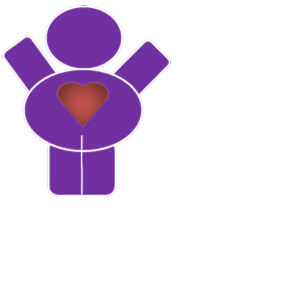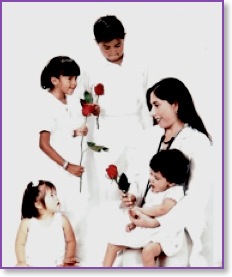Congenital Heart Disease
There are two types:
Acyanotic: structural heart defects, where there is adequate amount of oxygen in the blood, and the patient looks normal color (pink).
Cyanotic: structural heart defects which cause minor amount of oxygen exists in the blood and patients with look purplish coloration (cyanosis).
Most Common Congenital Heart Diseases
Ventricular Septal defect (VSD)
Atrial Septal defect (ASD)
Patent Ductus Arteriosus (PDA)
Atrioventricular Canal (AV Canal)
Coarctation of the Aorta (CoA)
Aortic Stenosis (AS)
Pulmonary Stenosis (PS)
Tetralogy of Fallot (TOF)
Transposition of Great Arteries (TGA)
Hypertrophic Cardiomyopathy (HC)
Ventricular Septal defect (VSD)
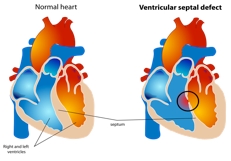
What is the cause?
The cause is usually unknown. Generally not inherited from parents and definitely not the fault of the parents.
How does it affect the heart?
If the opening is large, the heart must work harder than usual. The pressure and blood flow to the lungs are higher than normal so they can become congested.
How does it affect children?
If the opening is large, infants get tired while eating and sweat a lot when drinking from a bottle. They fail to thrive. Their growth is retarded. They breathe fast and look pale and sweaty as a result of the effort. If the aperture is small, it does not affect the child and could close by itself.
Can it be cured?
Yes, it can be cured. If severe, it is solved with surgery. In other cases it is not necessary to operate or can be controlled by medication.
What can kids do?
Usually, they can play and work normally. If the defect is large they cannot perform vigorous exercise.
What should parents do?
Follow doctor’s instructions
- Administer medicine.
- Visit your doctor regularly.
- Use extra care with dental procedures. Inform the dentist about the problem before any dental work to prevent infections of the heart.
Atrial Septal defect (ASD)
It is an opening that connects the top left and right sides of the heart (atria).
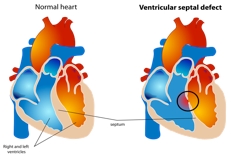
What is the cause?
The cause is usually unknown. Generally not inherited from parents and definitely not the fault of the parents.
How does it affect the heart?
If the opening is large, the heart must work harder than usual. The pressure and blood flow to the lungs are higher than normal, so that they can become congested.
How does it affect children?
If severe, they tire easily. Some children suffer from frequent colds even bronchopneumonia. Some children do not have symptoms.
Can it be cured?
Yes, it can be cured. Usually solved with surgery during childhood to prevent heart and lung problems in adulthood. When the opening is small, it may close spontaneously. Techniques currently exist for this defect to close without the need of open chest surgery by placing a device through cardiac catheterization.
What can kids do?
Usually the child can play and work normally.
What should parents do?
Follow doctors instructions.
- Administer the medicine.
- Visit your doctor regularly.
- Get cardiology check-ups regularly.
- Use extra care with dental procedures. Inform the dentist about the problem before any dental work to prevent heart infections.
Patent Ductus Arteriosus (PDA)

The fetal circulation is dependent on the flow of blood from the pulmonary artery to the aorta through a vein called patent ductus arteriosus. Normally this vessel is closed during the first hours of life. If it is kept open after birth then a condition exists that allows the passage of blood from the aorta to the pulmonary artery (lungs), increasing the amount of blood to the lungs, resulting in additional work for the heart and lungs.
It is a tube that connects the artery that distributes blood throughout the body (aorta) that carries the blood to the lungs (pulmonary artery), which exists during fetal life and that should have been closed a few hours after birth.
What is the cause?
The cause is usually unknown. It appears that having rubella during pregnancy may influence this defect. It is more common in premature infants.
How does it affect the heart?
If the opening is large, the heart must work harder than usual. The pressure and blood flow sent to the lungs are higher than normal, so that they can become congested.
How does it affect children?
If the duct is large the child tires easily. There is failure to thrive, so growth is retarded. Respiratory problems can be present frequently, they breathe fast and look pale and sweaty as a result of the efforts. If the connection is small, it does not affect the child.
Can it be cured?
Yes, it can and must be cured by surgery or other methods. If severe, it has to be resolved before the pressure in the lungs rises irreversibly.
What can kids do?
Once the PDA is closed, they can play and work normally.
What should parents do?
Follow doctor’s instructions:
- Administer medicine.
- Visit the doctor regularly.
- Use extra care with dental procedures. Inform the dentist about the problem before any dental work to prevent heart infections.
Atrioventricular Canal (AV Canal)
It is an opening that connects the left and right sides of the heart. The defect is caused when the heart’s walls and valves are not fully developed.
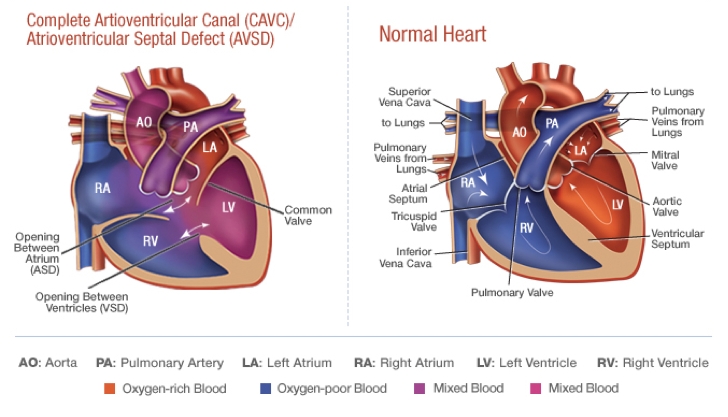
What is the cause?
The cause is usually unknown. Generally not inherited from parents and definitely not the fault of the parents. It is frequently associated with Down syndrome.
How does it affect the heart?
The heart must work harder than usual. The pressure and blood flow sent to the lungs are higher than normal, so that they can become congested.
How does it affect children?
They tire easily. There is a failure to thrive, so that growth slows down. They frequently suffer pneumonia, breathe fast and appear pale and sweaty as a result of the efforts.
Can it be cured?
Yes, it can and should be cured. Surgery must be performed before high pressure affects the lungs irreversibly, before the age of 2 in normal children, and before the age of 1 year in children with Down syndrome.
What can kids do?
If the defect is partial or small the can play and work normally. If the defect is large they cannot exercise hard.
What should parents do?
Follow the doctors instructions (pediatrician and cardiologist)
- Give medicine.
- Visit the doctor regularly.
- Have their regular pediatric revisions.
- Use extra care with dental procedures. Inform the dentist about the problem before any dental work to prevent heart infections.
Coarctation of the Aorta (CoA)
Is a narrowing of the artery that distributes blood throughout the body (aorta). Unlike aortic stenosis, the narrowing is located outside the heart.
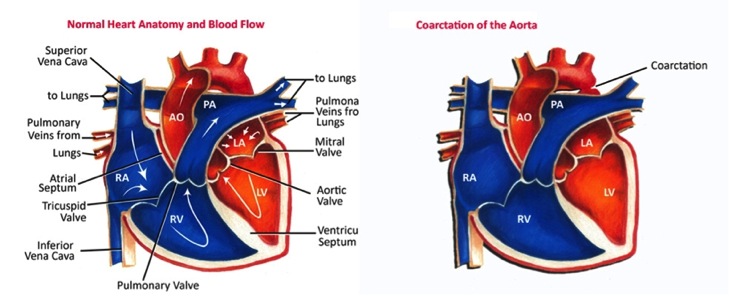
What is the cause?
The cause is usually unknown. Generally not inherited from parents and definitely not the fault of the parents. It is commonly seen in children with chromosomal abnormalities such as Turner syndrome.
How does it affect the heart?
If it is important, the main part of the heart (the left ventricle) must work harder to push blood through the narrowing of the artery.
How does it affect children?
If the narrowing is severe, the child may tire easily, have high blood pressure, and pulse at the groin is not felt. If it is mild it has no effect on the child.
Can it be cured?
Yes, it can be cured. If the narrowing is severe, should have surgery. If it is mild, it does not require surgery. Surgery must be performed when detected in the first days of life and is severe. If detected in children older than one month, the baby could be candidate for treatment with baloon angioplasty (cardiac catheterization).
What can kids do?
If severe, requires restriction of heavy exercise. If mild, can play and work normally.
What should parents do?
Follow doctors instructions:
- Administer medicine.
- Visit the doctor regularly.
- Perform follow-up studies when required (RX, ECG, echocardiogram).
- Use extra care with dental procedures. Inform the dentist about the problem before any dental work to prevent heart infections.
Aortic Stenosis (AS)
Is a narrowing of the valve that leads to the blood (oxygen) from the heart (left ventricle) to the whole body except the lungs.

What is the cause?
The cause is usually unknown. Generally not inherited from parents and definitely not the fault of the parents.
How does it affect the heart?
The main body (left ventricle) of the heart has to work harder to push blood through the narrowed valve.
How does it affect children?
If the narrowing is severe, the child may tire easily, they can faint, have chest pain with exertion or palpitations. If it is mild, they can generally have a normal life.
Can it be cured?
Yes, it can be cured. If the narrowing is severe, should undergo surgery. Sometimes you can open the valve using a balloon catheter without having to undergo surgery.
What can kids do?
If severe, requires restriction of heavy exercise. If mild, can play and work normally.
What should parents do?
Follow doctor’s instructions:
- Give medicine.
- Visit the doctor regularly.
- Perform follow-up studies: X-ray, ECG and echocardiogram or Angiotomography.
- Use extra care with dental procedures. Inform the dentist about the problem before any dental work to prevent heart infections.
Pulmonary Stenosis (PS)
A narrowing of the valve that leads to poorly oxygenated blood from the heart (right ventricle) to the lungs where it is oxygenated.

What is the cause?
The cause is usually unknown. Generally not inherited from parents and definitely not the fault of the parents.
How does it affect the heart?
The right side of the heart (right ventricle) must work harder to pump blood through the narrowed valve.
How does it affect children?
If the narrowing is severe, the child may tire easily with exercise. Cyanosis may occur when too little blood flows to the lungs to be oxygenated. If mild it has no effect on the child.
Can it be cured?
Yes, it can be cured. Surgery recommended if the narrowing is severe. However, it is often possible to open the valve using a balloon catheter without having to undergo surgery.
What can kids do?
Usually, the children can play and work normally.
What should parents do?
Follow doctors instructions:
- Give them medicine when indicated.
- Visit the doctor regularly.
- Will probably require follow-up studies: RX-up studies, ECG and echocardiogram.
- Use extra care with dental procedures. Inform the dentist about the problem before any dental work to prevent heart infections.
Tetralogy of Fallot (TOF)
It is the most common cyanotic congenital heart disease, named in honor of Dr. Arthur Fallot who described this heart defect in detail in 1888. It is a cluster of abnormalities in the heart that cause blood flowing through to have less oxygen than normal. The abnormalities in the structure of the heart are:
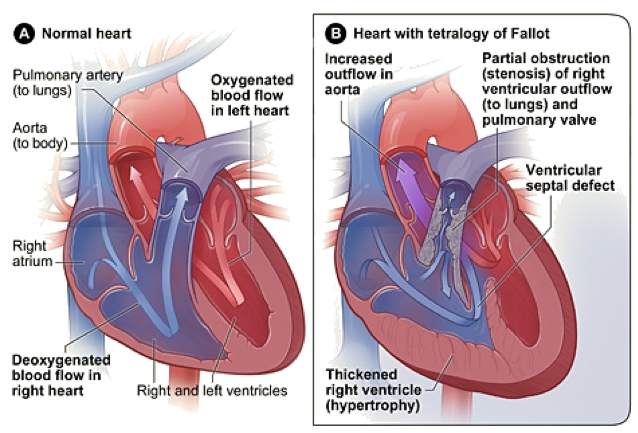
- An opening that connects the bottom left and right chambers of the heart (ventricular septal defect)
- The narrowing of the output path and the artery that carries blood from the heart to the lungs (pulmonary stenosis)
- The thickening of the muscle wall of the lower right side of the heart (right ventricular hypertrophy)
- Moving the aorta to the right, so that it is connected with the two ventricles (overriding Aorta).
According to some cardiologists, one could speak of Tetralogy of Fallot with only getting the first two, as the HVD is a consequence of them, and the overlapping of the aorta may occur in varying degrees. Tetralogy of Fallot is the most common cyanotic congenital heart disease, affecting between 5% and 10% of live births with congenital heart disease.
What is the cause?
The cause is usually unknown. Generally not inherited from parents and definitely not the fault of the parents.
How does it affect the heart?
Part of the blood that should go to the lungs for oxygenation instead deviates through opening in the wall VSD to the aorta. Consequently, the blood circulating through the body carries a very low oxygen level.
How does it affect children?
Children may get tired and turn blue (cyanotic) and when they can walk they adopt a squat position to recover when they feel tired. It can cause rapid breathing and fainting.
Can it be cured?
Yes, it can be cured in infancy or childhood. In some cases provisional intervention may be necessary before the final surgery.
What can kids do?
Before surgery children must limit their level of activity. After surgery, they can usually play and work normally.
What should parents do?
Follow doctor instructions:
- Give the medicine by a physician.
- Visit the doctor regularly.
- Undergo monitoring studies: RX, EKG, echocardiogram, cardiac catheterization.
- Use extra care with dental procedures. Inform the dentist about the problem before any dental work to prevent heart infections.
Transposition of Great Arteries (TGA)
It is a cyanotic congenital heart disease (the 2nd most frequent). In this condition the pulmonary artery and aorta are connected backwards to the ventricles. Therefore, pulmonary artery receives oxygenated blood from the left ventricle to which it is connected and mistakenly transports red blood (oxygenated) instead of blue to the lungs. The aorta receives oxygenated blood from the right ventricle to which it is mistakenly connected and carries blood red blue instead to the body.
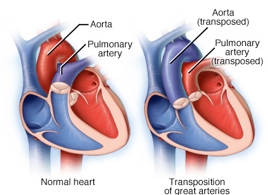
What is the cause?
The cause is usually unknown. Generally not inherited from parents.
How does it affect the heart?
Blood will not have enough oxygen throughout the body, making the baby look blue and the only way that oxygen-rich blood reaches the body is through another defect that connects the two routes. The interatrial communication allows the exchange of blood between the two atria, interventricular communication allows the exchange of blood between the two ventricles and the ductus arteriosus connects the pulmonary artery to the aorta.
How does it affect children?
Children can look tired and bluish (cyanotic), can have normal or agitated breathing and low-oxygen blood. Other body organs may be affected and damaged so it should be treated early.
Can it be cured?
A newborn may receive a medicine called prostaglandin to keep the ductus arteriosus open. The ductus arteriosus normally begins to close shortly after birth, but if it remains open, some oxygen-rich blood can reach the body.
If the baby is not born with other defects that allow some oxygen-rich blood circulating through the body, doctors have to create a defect called "ASD". In a procedure called balloon septostomy, a catheter with a balloon at the tip is used to create a hole in the wall that separates the right and left atria.
Medication and balloon septostomy are short-term solutions that allow the body to get some oxygen-rich blood to enable a surgical procedure to correct the transposition.
The most common surgery to correct transposition of the great arteries can be performed during the first month of life. It is called anatomic correction (Arterial Switch). During the procedure reverses the position of the arteries so that the pulmonary artery is connected to the right ventricle and the aorta to the left ventricle.
What should parents do?
Follow the instructions of the doctors, the baby may spend several days in the hospital after birth until the interventions carried out as the case requires. Once discharged:
- Administer the medicine.
- Visit the doctor regularly
- Follow-up monitoring studies: RX, EKG, Echocardiogram, cardiac catheterization and possibly an Angiotomography.
- Use extra care with dental procedures. Inform the dentist about the problem before any dental to prevent heart infections.
Hypertrophic Cardiomyopathy
It is a disease in which the heart's walls are thick which reduces the capacity and elasticity of the ventricles.

What is the cause?
Not attributed to any obvious cause, but is known to be inherited in a high percentage of cases, so that, if there is a family history, the child must be seen by a cardiologist, especially if he or she will be subjected to intense physical activity.
How does it affect the heart?
Due to the reduced capacity of the ventricles, the blood volume pumped is lower than normal. In some cases (Obstructive HCM), the heart muscle is so thickened that it obstructs the outflow of blood from the ventricle, which in turn leads to a further increase in thickness of the walls of the heart muscle, entering a vicious circle.
How does it affect children?
This condition does not usually become evident until adolescence, between the ages of 12 and 18. It is the leading cause of sudden death in young people. Patients may experience syncope, palpitations and chest pain.
Can it be cured?
Drugs can control and even eliminate the obstruction of the aortic valve, if there is one. The life expectancy of patients with HCM is highly variable, but generally does not differ from the general population (1% mortality / year).
What can kids do?
About half of patients with hypertrophic cardiomyopathy lead a normal life without treatment by simply avoiding situations of great physical effort.
What should parents do?
Follow doctor instructions:
- Give medicine.
- Visit the doctor regularly.
- Requires periodical follow-up studies: RX, EKG, echocardiogram,and sometimes stress tests.
- Use extra care with dental procedures. Inform the dentist about the problem before any work dental work to prevent infections of the heart.
- Stay well hydrated and avoid competitive physical activity.
